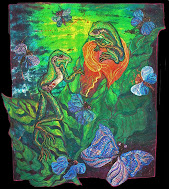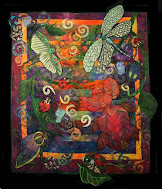Tuesday, January 12, 2010
The Needle Knows
The hardest working part of your sewing machine is your needle. Think about it. It's the contact point, the point to the exercise, the.heart of the issue. So it's worth knowing what needle you're using and why. Because I want to do machine free motion work with my machine, I want a needle that's going to help me do that best.
Are needles all the same?
Yes and no.
Yes, they have a shaft and a hole for the thread to go in.
No, there are huge differences in what that shaft and hole look like, that make them act very very differently.
We are, to be clear, talking strictly about home sewing machine needles. These always have a flat side in back, and that's one way to identify them.
Within that group there are several possibilities.
There are a bunch of specialty needles for certain things. I'm not going to touch on those, because they're labeled for those purposes.
Needle Brands
You can get needles that have every kind of sewing machine branded on the front. Basically Schmetz makes all of those needles. They are identical. Schmetz needles are an industry standard and well worth looking for. The only difference is Singer needles. Singer has it's own style and I recommend you use Singer needles only with Singer Machines. You can use a Schmetz needle on a Singer. But don't use a Singer needle on any other kind of machine. It may scar the hook.
Organ needles come in huge boxes and are suggested for free motion. They work quite well and are inexpensive. But they only come in point sizes and ball point/sharp variations. I think they're better used for computerized embroidery.
Point Styles
Sharp Point Needle
These needles have a sharp point. That means they have a clean punching power and create a smooth stitch line.They're set up for woven fabric. I always use a sharp needle for all free motion embroidery.
Ball Point Needles
These needles have a ball point at the edge. They wiggle through the fabric. They're set up to sew knitted goods without snagging. Because of how they're built, they don't really create a smooth stitch line. Although I don't use them with my Bernina's and Pfaffs, they are recommended for Janome/ New Home Machines for freemotion.
The Universal Needle
If you go into a shop and ask for needles and don't tell them what you want, this is what they'll give you. It' s a general multi purpose needle that does nothing really well.This is a combination of sharp and ball point needles. It's a horse designed by a committee. It kind-of sort-of works all the time, sort-of. It has a sharp needle shape with a gently balled end. Again, it doesn't leave a clean stitch line. I would avoid it for free motion. Better to use the right tool, than the almost right tool.
Needle Sizes
Needles are labeled with European and American Sizes. European sizes are 60.70.80.90,100,110. The American sizes are 10.12.14.16.18. Larger numbers mean larger needles.
For most embroidery I like a #90/14. If it's leaving too large a hole try a size smaller. If it's breaking constantly, try a size larger.
Topstitching vs. Regular Eye
A topstitching needle has a special big eye. This is so helpful. You can see it to thread it. But it reduces thread breakage massively as well.
Wrapping it up
My favorite needle is a 90 Topstitching needle. I find it reduces breakage and gives me a fabulous straight line to draw with. Try it yourself. I find it makes such a difference.
Are needles all the same?
Yes and no.
Yes, they have a shaft and a hole for the thread to go in.
No, there are huge differences in what that shaft and hole look like, that make them act very very differently.
We are, to be clear, talking strictly about home sewing machine needles. These always have a flat side in back, and that's one way to identify them.
Within that group there are several possibilities.
There are a bunch of specialty needles for certain things. I'm not going to touch on those, because they're labeled for those purposes.
Needle Brands
You can get needles that have every kind of sewing machine branded on the front. Basically Schmetz makes all of those needles. They are identical. Schmetz needles are an industry standard and well worth looking for. The only difference is Singer needles. Singer has it's own style and I recommend you use Singer needles only with Singer Machines. You can use a Schmetz needle on a Singer. But don't use a Singer needle on any other kind of machine. It may scar the hook.
Organ needles come in huge boxes and are suggested for free motion. They work quite well and are inexpensive. But they only come in point sizes and ball point/sharp variations. I think they're better used for computerized embroidery.
Point Styles
Sharp Point Needle
These needles have a sharp point. That means they have a clean punching power and create a smooth stitch line.They're set up for woven fabric. I always use a sharp needle for all free motion embroidery.
Ball Point Needles
These needles have a ball point at the edge. They wiggle through the fabric. They're set up to sew knitted goods without snagging. Because of how they're built, they don't really create a smooth stitch line. Although I don't use them with my Bernina's and Pfaffs, they are recommended for Janome/ New Home Machines for freemotion.
The Universal Needle
If you go into a shop and ask for needles and don't tell them what you want, this is what they'll give you. It' s a general multi purpose needle that does nothing really well.This is a combination of sharp and ball point needles. It's a horse designed by a committee. It kind-of sort-of works all the time, sort-of. It has a sharp needle shape with a gently balled end. Again, it doesn't leave a clean stitch line. I would avoid it for free motion. Better to use the right tool, than the almost right tool.
Needle Sizes
Needles are labeled with European and American Sizes. European sizes are 60.70.80.90,100,110. The American sizes are 10.12.14.16.18. Larger numbers mean larger needles.
For most embroidery I like a #90/14. If it's leaving too large a hole try a size smaller. If it's breaking constantly, try a size larger.
Topstitching vs. Regular Eye
A topstitching needle has a special big eye. This is so helpful. You can see it to thread it. But it reduces thread breakage massively as well.
Wrapping it up
My favorite needle is a 90 Topstitching needle. I find it reduces breakage and gives me a fabulous straight line to draw with. Try it yourself. I find it makes such a difference.
Subscribe to:
Post Comments (Atom)
Ellen Anne Eddy's Flowers on Youtube.com
Labels
lunatic fringe
(22)
design
(18)
life as an artist
(18)
lifestyle
(18)
story telling
(11)
art quilting
(8)
fiber art
(8)
art quilters
(7)
books
(6)
color
(6)
free motion
(6)
gardening
(5)
Thread Magic Garden
(4)
embroidery
(4)
quilters
(4)
quilting
(4)
C and T Publishing
(3)
craft
(3)
flowers
(3)
Christmas
(2)
What problem?
(2)
archetypes
(2)
beads
(2)
bias
(2)
bobbin work
(2)
classes
(2)
filling the grid
(2)
sewing
(2)
threads
(2)
zigzag stitch
(2)
Wizard of Oz
(1)
choir
(1)
knitting
(1)
machine stitching
(1)
movies
(1)
seasons
(1)
youtube
(1)
Like us on Facebook

Quiltposium, Fall2011

Ellen's New Article, Dance of Design
Essential Embroidery Stitches: Free Hand and Machine Embroidery Designs and Techniques.
The Butterfly Effect

Blog Archive
-
▼
2010
(63)
-
▼
January
(16)
- The Case for Kits-I have to follow the instructions?
- Thread Savy-Why dye! The Case for Hand-dyed Thread
- Thread Savy-Why dye! The Case for Hand-dyed Thread
- Thread Savy- Thick Metallic Threads
- Thread Savy- Thick Metallic Threads
- Musings: Art Outside the Box. Your Authentic Voice
- Thread Savy-Metallic Threads
- Thread Savy-Metallic Threads
- Thread Savy- Mono-filament Threads
- Thread Savy- Mono-filament Threads
- Thread Savy-Basic Embroidery Thread
- Thread Savy-Basic Embroidery Thread
- Hoop-Dee-Doo
- Hoop-Dee-Doo
- The Needle Knows
- The Needle Knows
-
▼
January
(16)
My Blog List
-
1 day ago
-
1 week ago
-
3 weeks ago
-
4 weeks ago
-
4 weeks ago
-
1 year ago
-
4 years ago
-
5 years ago
-
5 years ago
-
6 years ago
-
6 years ago
-
8 years ago
-
8 years ago
-
8 years ago
-
9 years ago
-
9 years ago
-
9 years ago
-
9 years ago
-
10 years ago
-
10 years ago
-
11 years ago
-
11 years ago
-
11 years ago
-
11 years ago
-
11 years ago
-
12 years ago
-
12 years ago
-
12 years ago
-
12 years ago
-
12 years ago
-
13 years ago
-
13 years ago
-
13 years ago
-
13 years ago
-
13 years ago
-
-
-

Facebook Badge
Labels
archetypes
(2)
art quilters
(7)
art quilting
(8)
beads
(2)
bias
(2)
bobbin work
(2)
books
(6)
C and T Publishing
(3)
choir
(1)
Christmas
(2)
classes
(2)
color
(6)
craft
(3)
design
(18)
embroidery
(4)
fiber art
(8)
filling the grid
(2)
flowers
(3)
free motion
(6)
gardening
(5)
knitting
(1)
life as an artist
(18)
lifestyle
(18)
lunatic fringe
(22)
machine stitching
(1)
movies
(1)
quilters
(4)
quilting
(4)
seasons
(1)
sewing
(2)
story telling
(11)
Thread Magic Garden
(4)
threads
(2)
What problem?
(2)
Wizard of Oz
(1)
youtube
(1)
zigzag stitch
(2)










3 comments:
Ellen thanks so much for this informative information.
Though I'm an old hand at using threads, you've shown me several ways to add to my knowledge. Thank you. Reading your blog always makes me want to rush to the machine and get started.
Thank You...again for sharing this information in a clear concise format. Much appreciated.
Post a Comment